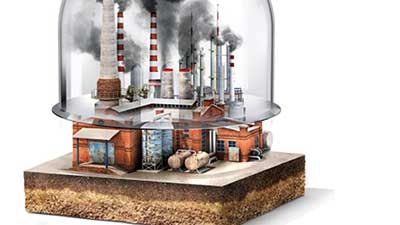Date: 18/04/2023
Relevance: GS-3: Science and Technology- developments and their applications and effects in everyday life.
Key Phrases: Renewable Energy, CCUS Policy, Decarbonization, Paris Agreement, Energy Transition, Budget, Net-Zero, Carbon Capture Utilization and Storage, NDCs.
Context:
- The Indian government is placing its bets on carbon capture technology
to achieve its green goals, and plans to reveal its carbon capture,
utilization and storage (CCUS) policy in the near future.
- Experts believe that CCUS technology will be crucial for India to meet its emissions targets.
Key Highlights:
- The government has given a significant push to its clean energy efforts,
declaring energy transition a priority in the 2023-24 Budget.
- The Ministry of Petroleum and Natural Gas (MoPNG) received a grant of ₹35,000 crores to deploy alternative technologies, including carbon capture, utilization, and storage (CCUS).
- Another fossil fuel department, the Ministry of Coal, is drawing up a dedicated plan to use CCUS as an effective measure for carbon capture and reduce emissions.
- India is the third-largest producer of carbon emissions globally, and this move towards CCUS aims to help the country cut down its carbon footprint while also being a tried-and-tested solution.
Why Is There a Focus on Carbon Capture?
- Increasing global scrutiny of India's emissions reductions policy and the need to cut down the country's carbon footprint have combined to make CCUS a popular solution.
- In 2019, India contributed close to 2.65% of the world's carbon emission, ranking it third in the world after China and the US, which are responsible for 28% and 15% of global emissions, respectively.
- In its latest nationally determined contribution (NDC) submitted to the United Nations, India committed to reducing the carbon intensity of its GDP by 45% (from 2005 levels) by 2030.
What Are the Figures Around CCUS?
- MoPNG states that India's energy sector contributes 72% of greenhouse gas emissions, with coal (54.5%), industrial (19.6%), land-use change (3.8%), and others (1.9%) being the major contributors.
- The 2030 CCUS draft aims to upscale CCUS techniques, and a large number of working models involve the capture of CO2 sources such as power-generation and industrial facilities that use either coal or biomass for fuel.
- Indian Oil Corporation (IOCL) has identified oilfields for potential CCUS projects and plans to transport CO2 captured from IOCL's refineries in Koyali, Gujarat, and Digboi, Assam, through pipelines to ONGC's Gandhar oilfield in Gujarat and Oil India's Naharkatiya oil field in Assam, respectively, for enhanced oil recovery and sequestration.
- Despite global pressure, India has not indicated any expiration
date for coal. Instead, the Ministry of Coal and Coal India (CIL) plans to
undertake CCUS projects.
- The Ministry plans to capture carbon at the pithead (coal mine's end), and coal gasification projects have been planned to meet the target of 100 million tonnes of coal gasification capacity in the country by 2030.
- State-owned enterprises will set manufacturing units such as Coal India, manufacturing major BHEL, GAIL, IOCL, Neyveli Lignite Corporation. The coal ministry has proposed a production-linked incentive for this.
India's Efforts in CCU
- NTPC intends to capture waste flue gas carbon dioxide and utilize the captured CO2 as resource material to develop a value-added product chain for CCU materials in India.
- Developing fuel-grade methanol by utilizing flue gas CO2, along with
green hydrogen, is one of the major steps to achieve the target of
generating green power.
- NTPC is also in discussions with various technology suppliers, while its R&D arm, NTPC Energy Technology Research Alliance, is building its technology as well.
- In August 2022, NTPC began a CCUS pilot at its Vindhyachal thermal power station. The plant was designed to capture 20 tonnes of CO2 every day from flue gas, and a hydrogen manufacturing unit will soon be set up at this location. With the captured carbon, 20 tonnes of methanol will also be manufactured.
The cost factor in CCUS
- One significant area of concern among industry players is the
cost involved in CCUS. However, it is expected to be an inherent expense
in the early stages only.
- There are opportunities for accessing low-cost funds that are available internationally to counter the initial cost.
Conclusion
- The government's push for clean energy through CCUS is a significant step towards India's transition towards cleaner sources of energy.
- Efforts by the Ministry of Petroleum and Natural Gas and the Ministry of Coal, along with NTPC's efforts in utilizing waste flue gas carbon dioxide, are a positive sign that India is moving towards a greener and more sustainable future.
Source: Business-Standard
Mains Question:
Q. What are the major challenges that India faces in implementing carbon capture and utilization technologies, and how can they be overcome? (150 words).






















